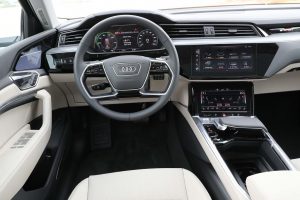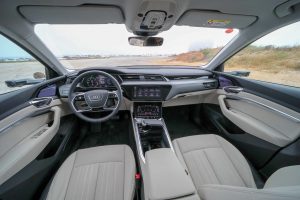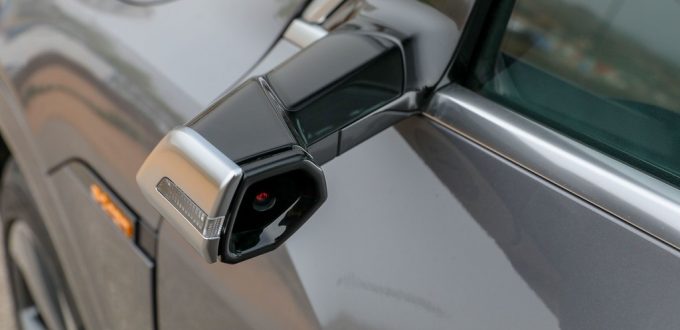Photos: Ronen Topelberg
Being a technical person I always get excited about new technology, gadgets and inventions. So it was hard for me to write this piece, a post about new exciting technology that is potentially dangerous to motorcyclists…
The new Virtual Side Mirrors
Advances in technology have done wonderful things for the motor vehicle industry. GPS navigation, engine management, cruise control and keyless entry are only a few convenient features available to us thanks to advances in technology.
Unfortunately, not all new inventions promote better or safer driving. One of these new features which is potentially dangerous for motorcyclists is the Virtual Side Mirrors introduced by Audi in the new e-tron.

The e-tron’s Virtual Side Mirrors replace the traditional exterior side mirrors and use high resolution cameras (1280×1080 pixels) to transmit images to high-contrast OLED screens located in the door trim.
These new Virtual Mirrors have a number of advantages. They have improved aerodynamics which will reduce drag and turbulence, resulting in lower energy consumption. They are supposed to have better field of vision and improved rear view vision at night and in poor weather conditions. In addition, they are supposed to adjust to changing light conditions, for example when going in and out of tunnels.
This is all great! So what’s the problem?
Why Virtual Mirrors May Not Be Such A Good Idea
Many accidents involving motorcycles are caused by drivers turning or changing lanes and hitting a motorcycle next to them. In most of these we hear the SMIDSY (“Sorry Mate I Did Not See You“, for the non-riders among you…) as an “excuse”.
Although the Virtual Mirrors are supposed to provide a wider field, and hence provide a better view of a motorcycle travelling next to the car, the new technology does not have enough “mileage” to test this. It has also been reported that strong sunlight on the screen results in very poor display or inability to view the projected images.
A bigger problem is the location of the OLED screens. They are located in the door trim, just above the door handle, which is lower than the traditional exterior mirrors (the spot drivers typically look at to check their mirrors).

Although reports suggest it doesn’t take long for the driver to adjust, the end result is the driver’s point of focus is both lower and closer. This increases the risk drivers will miss seeing motorcyclists around them as both their focus point and peripheral vision has shifted.
This problem will become a major issue if Audi go ahead with their plans to move the screens from the door trim to a central screen located in the centre console. This has the danger of creating “passive drivers” and “lazy drivers”, who do not bother to move their heads in order to look for objects moving next to them. Drivers who rely solely on glancing at a screen.
So are we developing a generation of drivers who will look around them a lot less than they should? With cameras replacing mirrors and camera assisted parking, will drivers look out the windows to look for motorcycles, pedestrians and other vehicles?
What can riders do?
It looks like Virtual Mirrors is the direction the industry is taking. Audi have already indicated this technology will be implemented in the future in other models. Lexus have announced their version, called “Digital Side View”, and Hyundai announced they have also developed a version to equip their cars.
The technology is still new and there is no doubt it will mature. Until such time, we as riders will have to be even more careful on the roads and improve our riding strategy. There are some basic strategies we all know (nothing new here) and we all must follow if we want to stay safe:
* Keep a buffer around to allow evasive action if needed
* Lane positioning is critical
* Draw attention by slightly changing position in the lane. A quick beep of the horn won’t hurt either
* Plan an “escape route”
* Avoid surprising drivers
* Don’t assume drivers can see you. Make eye contact when possible
* Be extra careful when filtering
Let’s be safe and hope technology will keep working for us and for our safety.
Be safe. Enjoy the ride.


I agree, it is dangerous not just for motorcyclists but also for other cars due to blind spots, with the same SMIDSY. Further how resilient the camera to moisture, humidity fogginess or road dirt spritz after rain, these are all tests that camera must be proven to be resilient to. All that combined with electric sensory to objects in proximity could potentially easily replace the old world tech.